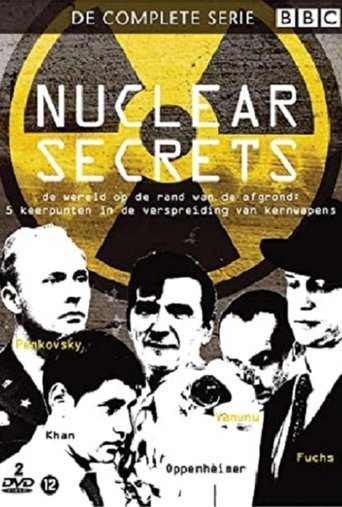
Nuclear Secrets (2007)
A series of spy thrillers exploring the key turning-points in the race for nuclear supremacy. From the development of the A-bomb, via the Cuban missile crisis, to the spread of nuclear weapons to the Middle East and beyond, each story is told through the eyes of the men who risked everything to proliferate their nuclear secrets and those who tried to stop them. Nuclear weapons and the actions of these men have transformed the face of war - and now the world could pay the price.
-

Episode 1 - The Spy From Moscow
Release Date: 2007-01-15Soviet Colonel Oleg Penkovsky was one of the highest-ranking Soviet officials ever to spy for the West, and he risked his life providing an unparalleled amount of information to MI6 and the CIA. At the height of the Cuban Missile Crisis, Kennedy could turn to technical evidence unknown to the rest of the world provided by "Agent Hero" – Penkovsky's codename. One of the most effective spies in MI6's history, Penkovsky soon realised the KGB were on his tail. With unprecedented access to KGB archives, the film shows the surveillance footage taken by the KGB as they trailed Penkovsky across Moscow in meetings with his British handlers – Janet Chisholm, a British diplomat's wife, and Greville Wynne, a British businessman. Declassified CIA transcripts reveal that as America was being targeted, so was Penkovsky. His dramatic story and tragic end is highly revealing of KGB operations at the height of the Cold War.
-

Episode 2 - Superspy
Release Date: 2007-01-22One man's mission started the Cold War. Superspy unearths how Klaus Fuchs stole the secrets of the Hiroshima bomb and gave these confidential details to the Soviet Union. During the Second World War, German refugee Klaus was posted to the highest security weapons laboratory in America. His assignment was to help design the world's first weapon of mass destruction. After joining Robert Oppenheimer's team, he became an expert on plutonium and secretly plotted how to contact the Soviet spymasters. Under the eyes of the FBI, he slowly pieced together America's atomic secrets and copied out his notes. Evading security, he smuggled out the complete blueprint of the Nagasaki A-bomb. In January 1942, Klaus met up with a young mother – who was, in fact, a Soviet spy – and disclosed the classified information of how to construct an A-bomb. In the spring of 1945, he conducted a series of meetings with his Soviet courier, "Harry Gold". By 1949, the FBI were on the hunt for the traitor. Klaus escaped to England, where he started a job which placed him at the heart of the British nuclear establishment. While in the UK, he continued to sell secrets. The superspy's downfall came when he confessed all to MI5, whom he told: "It's as though my mind has two compartments." But the consequences of his actions led the world to fear nuclear Armageddon.
-

Episode 3 - Superbomb
Release Date: 2007-01-29Two superpowers, one goal – the race for nuclear supremacy follows the Soviet Union and USA as they struggle to control the most powerful force on the planet and create a "superbomb" that could unleash an explosion 1,000 times greater than Hiroshima. In April 1946, nuclear scientist Edward Teller, who has become known as the father of the hydrogen bomb, arrived at Los Alamos Nuclear Laboratory to chair a secret conference on the most ambitious weapons project the world had ever seen: the creation of a "superbomb". Having met initial opposition from his boss, the father of the atomic bomb, Robert Oppenheimer, Teller believed he could build the ultimate weapon. In Kew Gardens in 1947, a secret rendezvous took place. Soviet Alexander Felisov met his contact who handed over intelligence regarding Teller's H-bomb. Unknown to Teller, his weapons programme had been infiltrated by a Soviet husband-and-wife team – "the volunteers". By 1951, Teller had made the breakthrough he craved when he tested the H-Bomb in Eniwetok Atoll, in the Pacific. For 15 minutes, he waited anxiously to discover that the island had vanished and, in its place, was a crater, two miles wide. While Teller triumphed in the US, the Soviets were desperate to develop a small bomb that could be dropped by a plane. Chief Scientist Andrei Sakharov was successful in developing this. Teller discovered what the Soviets were doing and secretly joined the FBI as an informant; he accused his contemporary, Robert Oppenheimer, of not acting in the interests of the US and destroyed his reputation with a powerful testimony. But it was too late. The Soviets now held the secret to wiping out any city in Europe. Doomsday was now just around the corner...
-

Episode 4 - Va'anunu and the Bomb
Release Date: 2007-02-09Mordechai Va'anunu was the man who was determined to tell the world about Israel's nuclear capabilities and, by doing so, created a world scandal. Va'anunu worked as a nuclear technician between 1977 and 1985, separating plutonium from uranium at the top-secret Israeli nuclear facility. Disgusted by how Israel treated him, and with a growing awareness of the dangers of nuclear weapons, Va'anunu collected evidence by taking 60 photos of the top-secret plutonium plant. Fast forward to September 1986, when The Sunday Times brought Vanunu to London and kept him isolated while they verified his story about Israel's nuclear plant. After weeks of isolation in a hotel, he popped out for a newspaper. A beautiful blonde by the news stand caught his eye and he followed her until he plucked up the courage to speak to the mysterious woman. They agreed to meet several more times and Cindy, as she was known to him, bought tickets for them to take a short break in Rome. This, however, was to be Va'anunu's downfall. Cindy was, in fact, a secret agent for Mossad, the Israeli secret service. He was drugged and smuggled back to Israel where he was tried and jailed for 18 years. He was released last year but was re-arrested for violating his conditions. While he remains a traitor to Israelis, he is heralded as a saviour for nuclear openness to many around the world.
-

Episode 5 - The Terror Trader
Release Date: 2007-02-16Could the father of the Pakistani bomb be the creator of the largest nuclear-smuggling ring ever known? This story reveals a cat-and-mouse tale of an out-of-control nuclear scientist and Western intelligence. In 1975, a young scientist copied top-secret blueprints from his Dutch Nuclear company. The thief in question was Dr AQ Khan, a Pakistani nuclear scientist who was working in the Netherlands. His job gave him access to the designs of the key nuclear process, Centrifuges. He flew to Pakistan over Christmas in 1975 with his family and wrote to his employers, stating that he had yellow fever. He never returned and went on to live a lavish lifestyle in Pakistan. Dr Khan's motivation was based by his fierce patriotism and his quest to ensure Pakistan was at the centre of nuclear supremacy. The president of Pakistan placed Khan in charge of his nuclear programme, project 706, and he used his network of contacts from Europe to start it up. In 1998, Khan tested his bomb design and, for the first time, Pakistan revealed itself to the world as a nuclear power. Khan immediately became a national hero. With fame came wealth and the CIA discovered that Khan had acquired a large property empire. The CIA and MI6 were unclear what Khan was up to but, as time went on, the clues grew more alarming. They set up a joint task force which eventually led to Dr Khan's "nuclear bazaar". The world saw for the first time the terrifying scale of Khan's activities. The president of Pakistan placed him under house arrest, where he remains today.
